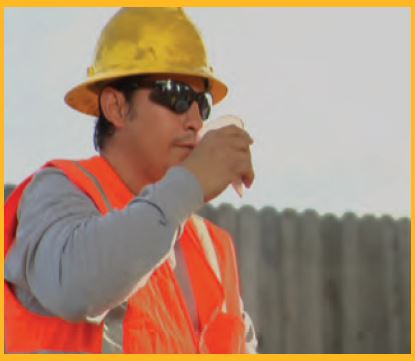OSHA•NIOSH INFO SHEET
Protecting Workers from Heat Illness
At times, workers may be required to work in hot environments for long periods. When the human body is unable to maintain a normal temperature, heat-relate illnesses can occur and may result in death.This fact sheet provides information to employers on measures they should take to prevent heat-related illnesses and death.
Factors That Increase Risk to Workers
• High temperature and humidity
• Direct sun exposure (with no shade)
• Indoor exposure to other sources of radiant heat (ovens, furnaces)
• Limited air movement (no breeze)
• Low fluid consumption
• Physical exertion
• Heavy personal protective clothing and equipment
• Poor physical condition or health problems
• Some medications, for example, different kinds of blood pressure pills or antihistamines
• Pregnancy
• Lack of recent exposure to hot working conditions
• Previous heat-related illness
• Advanced age (65+)
Health Problems Caused by Hot Environments
Heat Stroke is the most serious heat-related health problem. Heat stroke occurs when the body’s temperature regulating system fails and body temperature rises to critical levels. Heat stroke is a medical emergency that may rapidly result in death!
Symptoms of heat stroke include:
• Confusion
• Loss of consciousness
• Seizures
• Very high body temperature
• Hot, dry skin or profuse sweating and given liquids to drink.
If a worker shows signs of possible heat stroke:
• Heat stroke is a life-threatening emergency! • Cool the worker with cold compresses
Make sure that
While first aid measures are being implemented, call 911 and get emergency medical help.
Make sure that someone stays with the worker until help arrives; move the worker to a shaded, cool area and remove outer clothing; wet the worker with cool water and circulate the air to speed cooling; place cold wet cloths or ice all over the body or soak the worker’s clothing with cold water.
Heat Exhaustion is the next most serious heat related health problem:
Symptoms include: headache, nausea, dizziness, weakness, irritability, thirst, heavy sweating, elevated body temperature, decreased urine output
Preventing Heat Illness:
The best way to prevent heat illness is to make the work environment cooler.
Recommendations for all Work Environments (Indoors and Outdoors)
- Train workers and supervisors about the hazards leading to heat illness and ways to prevent them
- Train workers to recognize symptoms in themselves and others
- Train and encourage workers to immediately report symptoms in themselves and others
- If you have someone who is new to the job or who has been away for more than a week gradually increase the workload or allow more frequent breaks the first week
- Provide workers with plenty of cool water in convenient, visible locations close to the work area
- Remind workers to frequently drink small amounts of water before they become thirsty to maintain good hydration
- Workers should eat regular meals and snacks as they provide enough salt and electrolytes to replace those lost through sweating as long as enough water is consumed
- Set up a buddy system if possible
